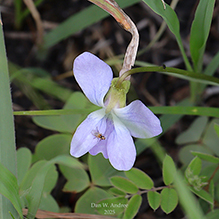grass sheathminer fly
(Cerodontha dorsalis)
Conservation • Description • Habitat • Ecology • Distribution • Taxonomy
|
|
||||||||||||||
Description |
Grass sheathminer fly is a common, small fly known for its distinctive larval feeding habits. It occurs in the United States, southern Canada, Mexico, Central America, Brazil, and Puerto Rico. The larvae have been recorded feeding on many wild and cultivated species in the family Poaceae, including barley, bluegrass, brome, corn, reed canarygrass, goose grass, oat, orchard grass, panicgrass, rye, timothy, wheat, and wheatgrass. The young larvae feed on the parenchyma (inner tissue) within the blade of grass, leaving a narrow visible trail (mine). They feed downwards, eventually entering the leaf sheath and sometimes even the stem. This is the behavior that gives the fly its common name. The larvae pupate within the mine. For small flies like Agromyzidae, wing length is often given in taxonomic descriptions as a measure of size, rather than body length. For Cerodontha dorsalis, the wing length of adults is variable, ranging from 1⁄16″ to ⅛″ (2.4 to 3.2 mm). The frons (upper part of the front of the head, corresponding to the forehead) is orangish yellow, The genae (cheeks) and face are also orangish yellow. The genae are broad and are about one-third the height of the eye. On the antennae, the third segment is long and black, with a short spine at the upper corner. There are two geographically isolated color forms. The eastern form is more pale and the western form is more black. Though it was investigated in some detail, the reason for the difference has not been satisfactorily explained. Only the typical (eastern) form occurs in Minnesota. The following description is of the eastern form. The mesonotum (upper part of the thorax) is matte grayish black on the front half, orangish yellow on the rear half. There is a transverse suture (horizontal groove) across the mesonotum. On each side of the mesonotum, there is a longitudinal row of dorsocentral bristles (dc), consisting of three longer bristles located behind the transverse suture and one longer bristle located in front of it. There are no acrostichals (minute hairs) between the dorsocentral bristles. On each side of the thorax, the notopleuron (ttriangular area immediately below or to the side of the transverse suture) is yellow. The scutellum (the plate between the abdomen and the thorax) is yellow in the center and black on the margins. It has only one pair of bristles. On each leg, the femur (third segment) is bright yellow. The wings are clear. The subcosta vein runs parallel to the R1 vein and reaches the costa (vein on the leading edge of the wing), rather than terminating in the R1 vein. Vein M1+2 ends nearest to the wing tip. |
Size |
Wing length: 1⁄16″ to ⅛″ (2.4 to 3.2 mm) |
Similar Species |
Habitat and Hosts |
Species in the family Poaceae, including barley, bluegrass, brome, corn, reed canarygrass, goose grass, oat, orchard grass, panicgrass, rye, timothy, wheat, and wheatgrass |
Ecology |
Season |
Multiple overlapping generations per year: May to October |
Behavior |
|
Life Cycle |
The larvae pupate within the mine. |
Larva Food |
|
Adult Food |
|
Distribution |
||
|
Sources |
|
| 7/16/2025 | ||
Occurrence |
||
|
||
Taxonomy |
|
Order |
|
Suborder |
Brachycera |
Infraorder |
Cyclorrhapha |
Zoosection |
Schizophora |
Zoosubsection |
Acalyptratae |
Superfamily |
Opomyzoidea |
Family |
Agromyzidae (leaf miner flies) |
Subfamily |
Phytomyzinae |
Genus |
Cerodontha |
Subgenus |
Cerodontha |
Subordinate Taxa |
|
|
|
Synonyms |
|
Odontocera dorsalis |
|
Common Names |
|
grass sheathminer (larva) grass sheathminer fly (adult) |
|
Glossary
Femur
On insects and arachnids, the third, largest, most robust segment of the leg, coming immediately before the tibia. On humans, the thigh bone.
Frons
The upper front part of an insect’s face, roughly corresponding to the forehead.
Gena
In insects: The area between the compound eye and the mandible; the cheek. In birds: The area between the the angle of the jaw and the bill; the feathered side (outside) of the under mandible. Plural: genae.
Mesonotum
The principal exoskeletal plate on the upper (dorsal) part of the middle segment of the thorax of an insect.
Scutellum
The exoskeletal plate covering the rearward (posterior) part of the middle segment of the thorax in some insects. In Coleoptera, Hemiptera, and Homoptera, the dorsal, often triangular plate behind the pronotum and between the bases of the front wings. In Diptera, the exoskeletal plate between the abdomen and the thorax.
Visitor Photos |
||
Share your photo of this insect. |
||
This button not working for you? |
||
Dan W. Andree |
 |
Tiny fly on a Prairie Violet blossom... This tiny fly like insect landed on the prairie violet out at the Twin Valley Prairie SNA. Just thought I'd share it. Funny little creature. Not a detailed enough insect so not expecting you to identify what it is just thought you may find it interesting. |
MinnesotaSeasons.com Photos |
||
|
||
|
||

Slideshows |
|

Visitor Videos |
||
Share your video of this insect. |
||
This button not working for you? |
||
|
Other Videos |
||
|

Visitor Sightings |
||
Report a sighting of this insect. |
||
This button not working for you? |
||
MinnesotaSeasons.com Sightings |
||
|

|
Created: 7/16/2025 Last Updated: © MinnesotaSeasons.com. All rights reserved. |

